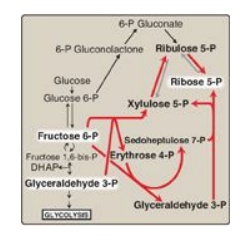Reversible Nonoxidative Reactions
| Home | | Biochemistry |Chapter: Biochemistry : Pentose Phosphate Pathway and Nicotinamide Adenine Dinucleotide Phosphate
The nonoxidative reactions of the pentose phosphate pathway occur in all cell types synthesizing nucleotides and nucleic acids.
REVERSIBLE NONOXIDATIVE REACTIONS
The nonoxidative
reactions of the pentose phosphate pathway occur in all cell types synthesizing
nucleotides and nucleic acids. These reactions catalyze the interconversion of
sugars containing three to seven carbons (see Figure 13.2). These reversible
reactions permit ribulose 5-phosphate (produced by the oxidative portion of the
pathway) to be converted either to ribose 5-phosphate (needed for nucleotide synthesis;)
or to intermediates of glycolysis (that is, fructose 6-phosphate and
glyceraldehyde 3-phosphate). For example, many cells that carry out reductive
biosynthetic reactions have a greater need for NADPH than for ribose
5-phosphate. In this case, transketolase (which transfers two-carbon units in a
thiamine pyrophosphate [TPP]-requiring reaction)and transaldolase (which
transfers three-carbon units) convert the ribulose 5-phosphate produced as an
end product of the oxidative reactions to glyceraldehyde 3-phosphate and
fructose 6-phosphate, which are glycolytic intermediates. In contrast, when the
demand for ribose for nucleotides and nucleic acids is greater than the need
for NADPH, the nonoxidative reactions can provide the ribose 5-phosphate from glyceraldehyde
3-phosphate and fructose 6-phosphate in the absence of the oxidative steps
(Figure 13.3).
In addition to transketolases, TPP is required by
the enzyme complexes pyruvate dehydrogenase, α-ketoglutarate dehydrogenase of
the citric acid cycle, and branched-chain α-keto acid dehydrogenase of
branched-chain amino acid catabolism.

Figure 13.3 Formation of
ribose 5-phosphate from intermediates of glycolysis. P = phosphate; DHAP =
dihydroxyacetone phosphate.
Related Topics
